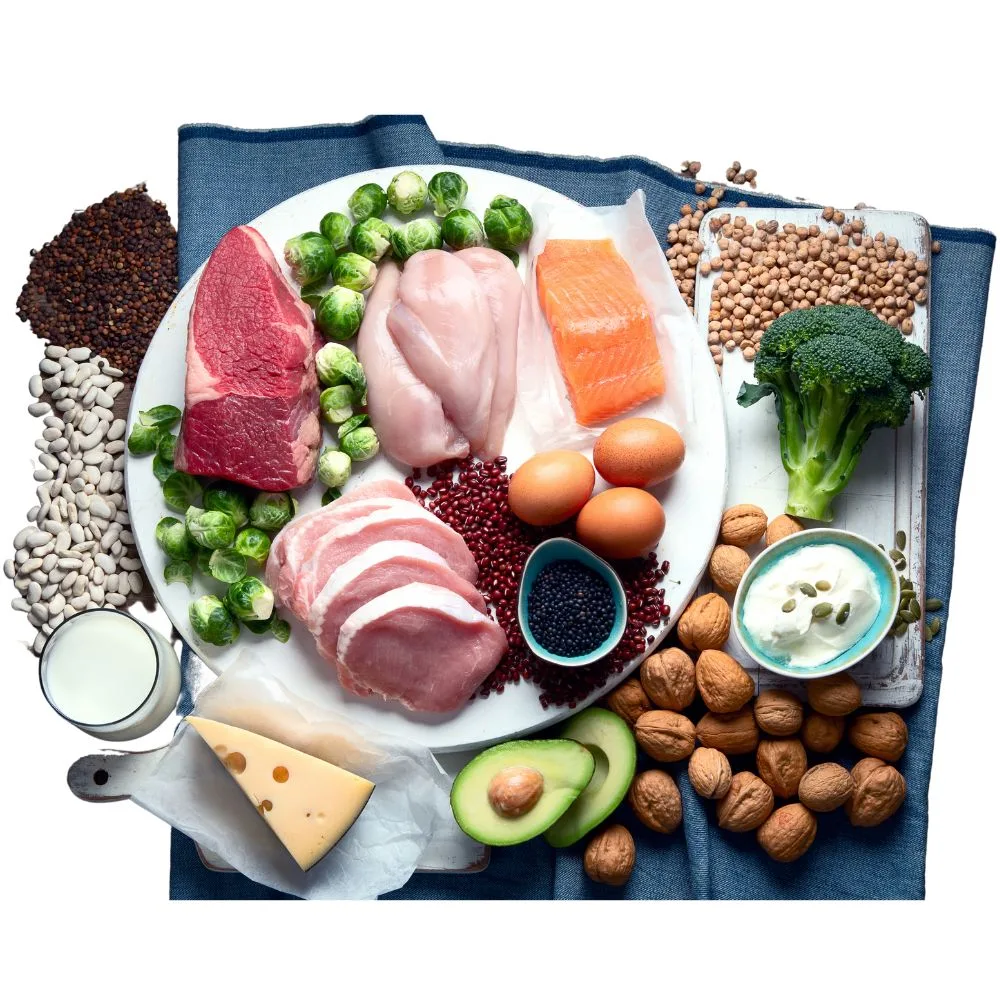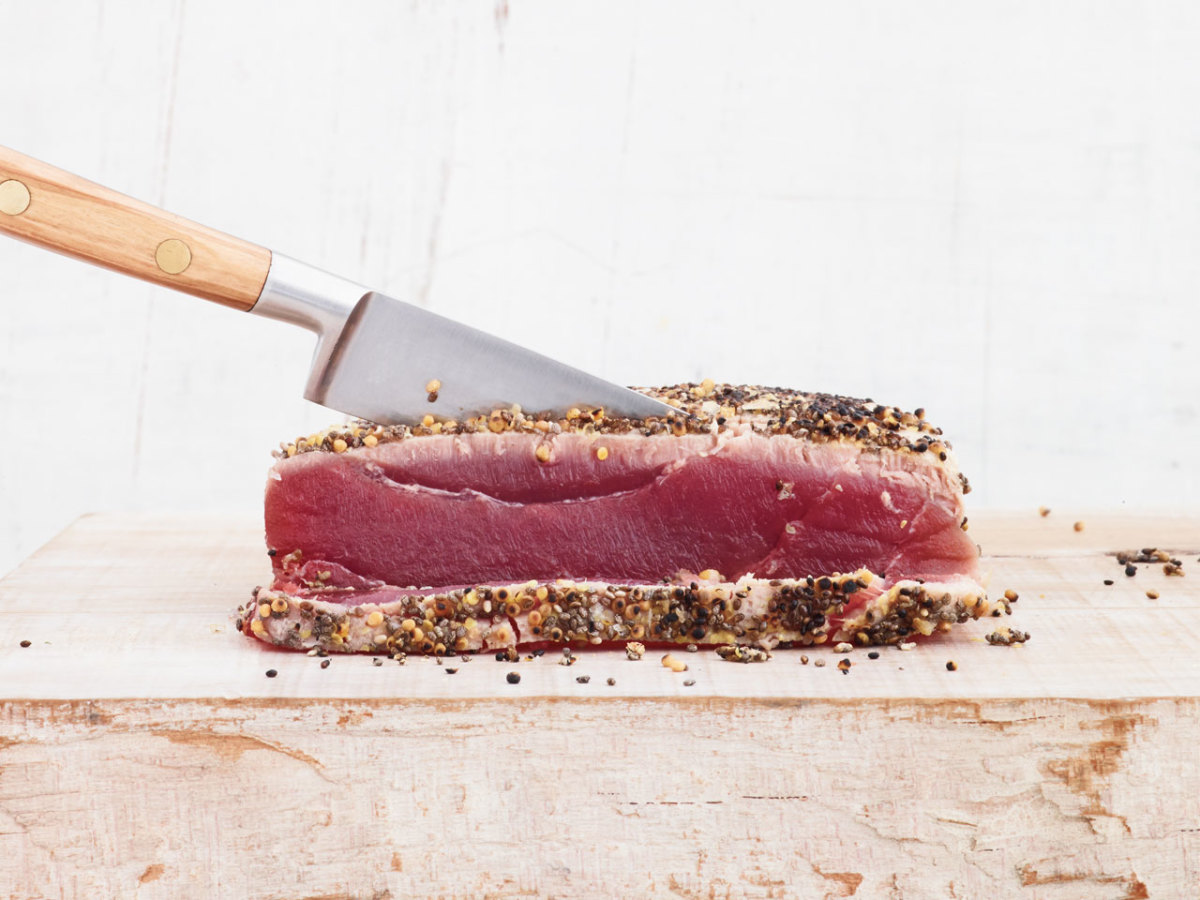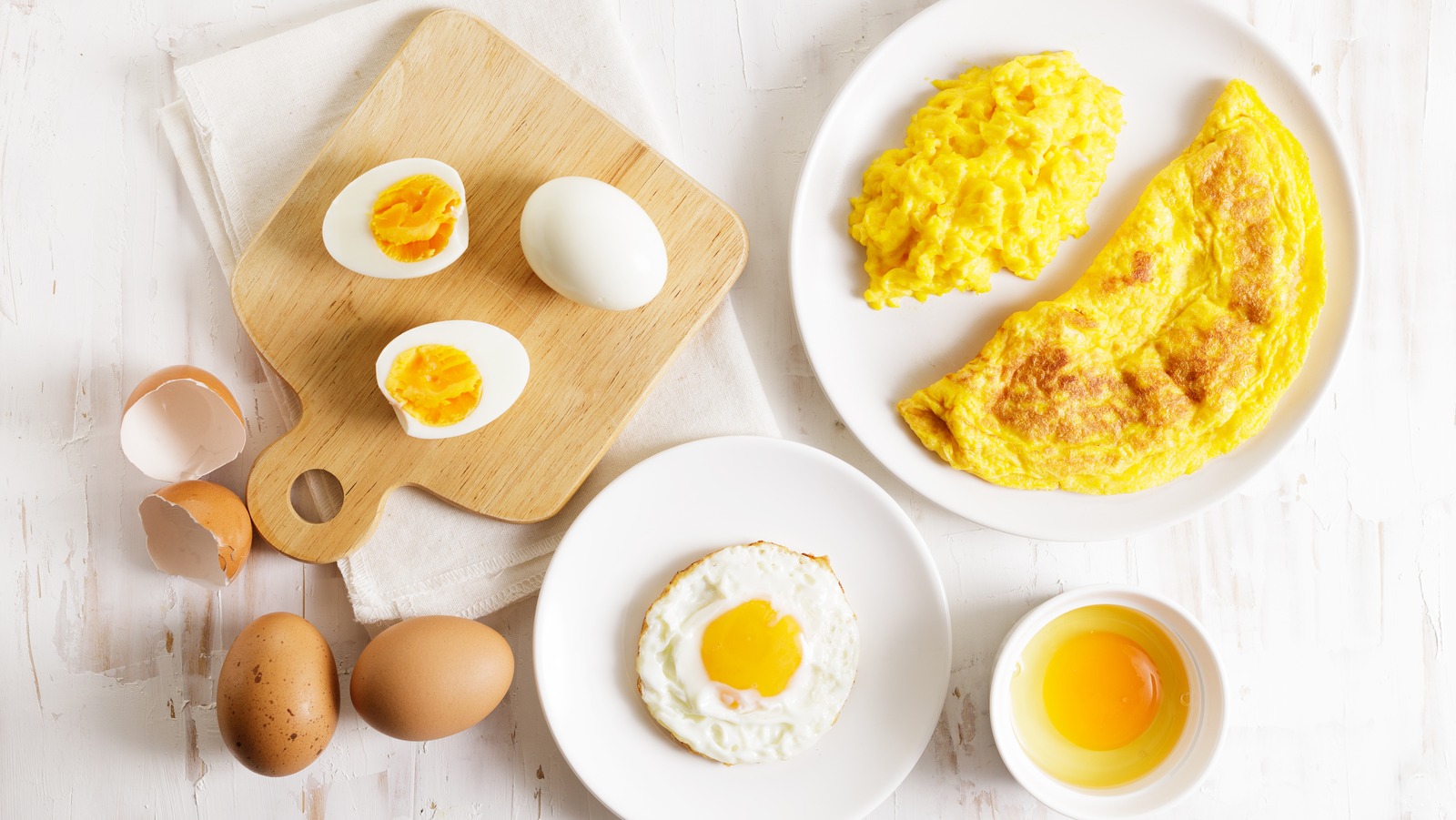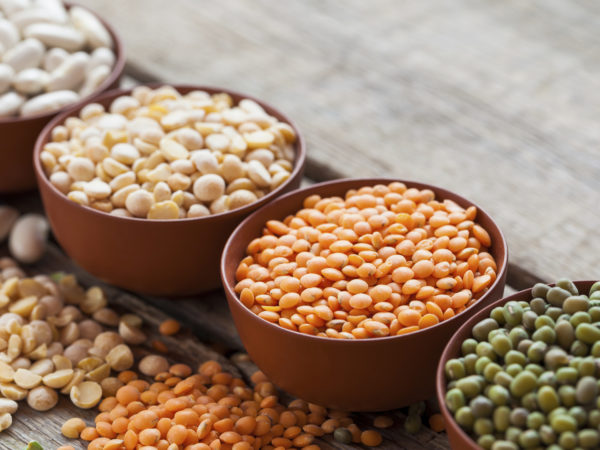Protein is a fundamental building block for your body, playing a crucial role in everything from muscle growth and repair to hormone production and immune function. Whether you’re an athlete striving for peak performance, someone looking to manage their weight, or simply aiming for a healthier lifestyle, ensuring adequate protein intake is essential.

This comprehensive guide provides you with a detailed list of high-protein foods, thoughtfully organized by food group, to help you effortlessly incorporate more protein into your diet at every meal.
We’ll explore the unique benefits of each food group, highlight specific examples of protein powerhouses, and offer practical tips for incorporating them into your daily routine. Get ready to discover a diverse and delicious array of protein sources that will fuel your body and help you achieve your health and fitness goals!
Table of Contents
Why is Protein So Important? Understanding the Power of Protein
Before we dive into the list, let’s briefly recap why protein is a non-negotiable part of a healthy diet:
- Muscle Growth and Repair: Protein provides the amino acids – the building blocks – necessary to build and repair muscle tissue. This is crucial for athletes, weightlifters, and anyone engaging in regular exercise, as well as for maintaining strength as we age.
- Weight Management: Protein is more satiating than carbohydrates or fats, meaning it helps you feel fuller for longer after eating. This can help reduce overall calorie intake, making it a valuable tool for weight loss or maintenance.
- Blood Sugar Control: Protein helps slow down the absorption of sugar into the bloodstream, preventing energy spikes and crashes and promoting stable blood sugar levels.
- Hormone Production: Many hormones, such as insulin and growth hormone, are made of protein.
- Enzyme Function: Enzymes, which facilitate countless chemical reactions in the body, are also proteins.
- Immune System Support: Antibodies, which help your body fight off infection, are made of protein.
- Healthy Hair, Skin, and Nails: Protein is a key component of these tissues.
High-Protein Food Groups: A Detailed Guide
Let’s explore the diverse world of high-protein foods, categorized by food group for easy reference:
1. Lean Meats: Classic Complete Protein Sources

Lean meats are renowned for being excellent sources of complete protein, providing all nine essential amino acids your body needs.
- Benefits: Chicken breast is a versatile, widely available, and affordable lean protein option. It’s low in fat and packed with protein, making it a favorite among fitness enthusiasts and health-conscious individuals alike. It’s also a good source of niacin (important for energy metabolism) and vitamin B6 (involved in protein metabolism).
- Protein Content: Around 31 grams of protein per 100 grams (3.5 ounces) of cooked chicken breast.
- Serving Ideas: Grilled, baked, roasted, poached, shredded in salads, added to stir-fries, soups, stews, or used in sandwiches and wraps.
- Benefits: Similar to chicken breast, turkey breast is another lean protein powerhouse that’s low in fat and high in protein. It also provides selenium, an important antioxidant that plays a role in thyroid function and immune health.
- Protein Content: About 30 grams of protein per 100 grams (3.5 ounces) of cooked turkey breast.
- Serving Ideas: Roasted, sliced for sandwiches, used in salads, or ground turkey as a base for chili, meatballs, or burgers.
- Benefits: When choosing lean cuts of beef (like sirloin, tenderloin, or eye of round), you can enjoy the benefits of red meat while minimizing saturated fat intake. Lean beef is a good source of protein, iron (essential for red blood cell production), zinc (important for immune function), and B vitamins (involved in energy metabolism).
- Protein Content: About 26 grams of protein per 100 grams (3.5 ounces) of cooked lean beef.
- Serving Ideas: Grilled steak, lean beef stir-fry, beef and vegetable skewers, lean ground beef in tacos, chili, or pasta sauces.
2. Fish and Seafood: Protein-Packed with Heart-Healthy Fats
Fish and seafood are not only excellent sources of protein but also provide omega-3 fatty acids, which have numerous health benefits, including reducing inflammation and supporting heart and brain health.
- Benefits: Salmon is a fatty fish that’s rich in both protein and omega-3s, particularly EPA and DHA, which are known for their heart-health benefits. It’s also a good source of vitamin D, a nutrient that many people are deficient in.
- Protein Content: About 20 grams of protein per 100 grams (3.5 ounces) of cooked salmon.
- Serving Ideas: Grilled, baked, pan-seared, smoked, added to salads, or used in sushi.
- Benefits: Tuna is another great source of protein and omega-3s, though the omega-3 content can vary depending on the type of tuna. Light tuna (skipjack) is generally lower in mercury than white albacore tuna, making it a better choice for frequent consumption.
- Protein Content: About 25 grams of protein per 100 grams (3.5 ounces) of canned tuna (in water).
- Serving Ideas: Canned tuna is convenient for salads, sandwiches, or pasta dishes. Fresh tuna can be grilled, seared, or used in sushi.
- Benefits: Shrimp is a low-calorie, low-fat, high-protein option. It’s also a good source of iodine, a mineral that’s crucial for proper thyroid function.
- Protein Content: About 24 grams of protein per 100 grams (3.5 ounces) of cooked shrimp.
- Serving Ideas: Grilled, sautéed, added to salads, stir-fries, pasta dishes, or enjoyed as an appetizer.
- Benefits: Cod is a lean, white fish that’s a good source of protein and low in fat. It also provides selenium (an antioxidant) and phosphorus (important for bone health).
- Protein Content: About 18 grams of protein per 100 grams (3.5 ounces) of cooked cod.
- Serving Ideas: Baked, broiled, pan-fried, used in fish tacos, or added to soups or stews.
3. Eggs: Nature’s Versatile Protein Package

Eggs are a nutritional powerhouse, providing high-quality, complete protein along with essential vitamins and minerals. They are also incredibly versatile and budget-friendly.
- Benefits: Egg yolks are a source of healthy fats and nutrients like choline (important for brain health) and lutein (beneficial for eye health).
- Protein Content: About 6 grams of protein per large egg.
- Serving Ideas: Scrambled, fried, poached, boiled, made into omelets or frittatas, added to salads, sandwiches, or used in baking.
4. Dairy Products: Calcium, Protein, and Creamy Goodness

Dairy products are excellent sources of both protein and calcium, a mineral that’s vital for strong bones and teeth. They also offer other important nutrients like vitamin D and potassium.
- Benefits: Milk naturally contains two types of protein: whey and casein. Whey is fast-digesting, while casein is slow-digesting. Milk is also a good source of calcium, vitamin D (if fortified), and potassium.
- Protein Content: About 8 grams of protein per cup (8 ounces) of milk.
- Serving Ideas: Enjoy it plain, use it as a base for smoothies, add it to cereal or oatmeal, or use it in cooking and baking. Choose low-fat or skim milk to reduce saturated fat intake.
- Benefits: Greek yogurt undergoes a straining process that removes some of the liquid whey, resulting in a thicker consistency and a higher protein concentration than regular yogurt. It’s also a good source of probiotics, live bacteria that are beneficial for gut health.
- Protein Content: About 15-20 grams of protein per cup (depending on the brand).
- Serving Ideas: Enjoy it plain or with fruit, nuts, and seeds. Use it as a healthier substitute for sour cream or mayonnaise in recipes.
- Benefits: Cottage cheese is a fresh, unripened cheese that’s high in casein protein. This makes it a great choice for a slow-digesting protein source, providing a sustained release of amino acids. It’s also relatively low in fat and calories compared to many other cheeses.
- Protein Content: About 25 grams of protein per cup.
- Serving Ideas: Enjoy it plain or with fruit (like peaches or pineapple), vegetables (like tomatoes and cucumbers), or whole-grain crackers. Use it in dips, spreads, or as a filling for omelets or lasagna.
- Benefits: Hard cheeses are concentrated sources of protein and calcium. They are also flavorful additions to many dishes.
- Protein Content: Varies depending on the type, but generally around 7-8 grams of protein per ounce.
- Serving Ideas: Enjoy in moderation as a snack, add to sandwiches, salads, or pasta dishes. Use them grated as a topping for soups, vegetables, or casseroles.
5. Legumes: Plant-Based Protein with a Fiber Bonus

Legumes, which include beans, lentils, and chickpeas (garbanzo beans), are nutritional powerhouses. They are excellent sources of plant-based protein and dietary fiber, which is important for digestive health and blood sugar control. They are also rich in various vitamins and minerals.
- Benefits: Beans are incredibly versatile and come in numerous varieties, each with its own unique flavor and texture. They are a good source of protein, fiber, iron (important for red blood cell production), and folate (essential for cell growth and division).
- Protein Content: About 15 grams of protein per cup of cooked beans.
- Serving Ideas: Add beans to soups, stews, salads, chili, or use them as a base for veggie burgers. They can also be mashed or pureed to create dips or spreads.
- Benefits: Lentils are relatively quick-cooking legumes that are packed with protein, fiber, and iron. They come in various colors, including brown, green, red, and yellow, each with a slightly different flavor profile.
- Protein Content: About 18 grams of protein per cup of cooked lentils.
- Serving Ideas: Use lentils in soups, stews, salads, or as a side dish. They can also be used to make lentil loaf or veggie burgers.
- Benefits: Chickpeas are a good source of protein, fiber, and manganese (a trace mineral involved in bone formation and metabolism). They have a nutty flavor and a firm texture.
- Protein Content: About 15 grams of protein per cup of cooked chickpeas.
- Serving Ideas: Use chickpeas to make hummus (a creamy dip), add them to salads, roast them for a crunchy snack, or use them in curries, stews, or falafel.
6. Nuts and Seeds: Portable Protein and Healthy Fats

Nuts and seeds are not only convenient and portable snacks but also excellent sources of healthy fats, protein, fiber, vitamins, and minerals.
- Benefits: Almonds are a good source of protein, monounsaturated fats (which are heart-healthy), vitamin E (an antioxidant), and magnesium (important for muscle function and bone health).
- Protein Content: About 6 grams of protein per ounce (about 23 almonds).
- Serving Ideas: Enjoy almonds as a snack, add them to salads, yogurt, or oatmeal. Use almond butter as a spread or in smoothies.
- Benefits: Although technically a legume, peanuts are often categorized with nuts due to their similar nutritional profile. They provide protein, healthy fats, and niacin (a B vitamin involved in energy metabolism).
- Protein Content: About 7 grams of protein per ounce (about 28 peanuts).
- Serving Ideas: Eat peanuts as a snack, add them to trail mix, or use peanut butter in sandwiches, smoothies, or sauces.
- Benefits: Pumpkin seeds, also known as pepitas, are a good source of protein, zinc (important for immune function), iron, and magnesium. They also contain phytosterols, which may help lower cholesterol levels.
- Protein Content: About 8 grams of protein per ounce.
- Serving Ideas: Enjoy pumpkin seeds as a snack, add them to salads, or use them as a topping for yogurt, oatmeal, or soups.
- Benefits: Chia seeds are tiny but mighty, providing a good dose of protein, fiber, omega-3 fatty acids, and calcium. They absorb liquid and form a gel-like consistency, making them useful in puddings and for adding texture to smoothies.
- Protein Content: About 5 grams of protein per 2 tablespoons.
- Serving Ideas: Add chia seeds to smoothies, yogurt, or oatmeal. Use them to make chia pudding by soaking them in milk or a milk alternative.
- Benefits: Sunflower seeds offer protein, healthy fats, vitamin E, and selenium.
- Protein Content: About 6 grams per ounce.
- Serving Ideas: Enjoy as a snack, add to salads, or use as a topping for yogurt or oatmeal.
7. High-Protein Vegetables: Boosting Protein in Unexpected Places

While vegetables are not typically the first food group that comes to mind when thinking about protein, certain vegetables offer a decent amount and can contribute to your overall protein intake. Including these vegetables in your meals is a great way to add extra nutrients and a little extra protein.
- Benefits: Spinach is a nutritional powerhouse, packed with vitamins (A, C, K), minerals (iron, folate), antioxidants, and even a bit of protein.
- Protein Content: About 3 grams of protein per cup of cooked spinach.
- Serving Ideas: Add spinach to salads, smoothies, omelets, soups, stews, or sauté it as a side dish.
- Benefits: Broccoli is a cruciferous vegetable that’s not only a good source of fiber and vitamins (C and K) but also provides a bit of protein.
- Protein Content: About 2.6 grams of protein per cup of chopped broccoli.
- Serving Ideas: Steam, roast, stir-fry, or add broccoli to soups, salads, or casseroles.
- Benefits: These mini cabbages are surprisingly high in protein for a vegetable. They also offer fiber, vitamins C and K, and antioxidants.
- Protein Content: About 3 grams of protein per cup of cooked Brussels sprouts.
- Serving Ideas: Roast them with olive oil and seasonings, sauté them with garlic, or add them to salads (shredded or halved).
- Benefits: Asparagus provides a bit of protein along with folate, vitamin K, and antioxidants. It’s also a good source of inulin, a type of prebiotic fiber that nourishes beneficial gut bacteria.
- Protein Content: About 3 grams of protein per cup of cooked asparagus.
- Serving Ideas: Grill, roast, steam, stir-fry, or add asparagus to salads or omelets.
- Benefits: Mushrooms, especially varieties like Portobello and cremini, offer a surprising amount of protein for a vegetable. They also provide B vitamins, selenium, and potassium.
- Protein Content: Around 3-4 grams of protein per cup of sliced, cooked mushrooms.
- Serving Ideas: Sautéed, grilled, added to stir-fries, soups, stews, or omelets. Portobello mushrooms can even be used as a “burger” base.
8. Grains: More Protein Than You Think
Certain grains are surprisingly good sources of plant-based protein, making them valuable additions to a balanced, high-protein diet.
- Benefits: Quinoa is often called a “super grain” because it’s a complete protein, containing all nine essential amino acids. It’s also a great source of fiber, iron, magnesium, and antioxidants.
- Protein Content: About 8 grams of protein per cup of cooked quinoa.
- Serving Ideas: Use quinoa as a base for salads, bowls, or as a side dish instead of rice. You can also add it to soups or stews for a protein and fiber boost.
- Benefits: Oats are a breakfast staple for good reason. They’re packed with fiber, particularly beta-glucan, a soluble fiber that has been shown to lower cholesterol levels. They also provide a decent amount of protein.
- Protein Content: About 5-6 grams of protein per half-cup of dry oats (which makes about 1 cup cooked).
- Serving Ideas: Enjoy as oatmeal (cooked with water or milk), overnight oats, or use in baking recipes like muffins, granola bars, or even as a binder in veggie burgers.
- Benefits: Although called “rice,” wild rice is actually an aquatic grass seed. It has a slightly nutty flavor and a chewy texture. It provides more protein than most other rice varieties and is also a good source of fiber, manganese, and antioxidants.
- Protein Content: Around 6-7 grams of protein per cup of cooked wild rice.
- Serving Ideas: Use as a side dish, in salads, or in soups and stews. It can also be combined with brown rice or other grains.
- Benefits: Despite its name, buckwheat is not related to wheat and is naturally gluten-free. It offers a good amount of protein along with fiber, magnesium, and copper.
- Protein Content: Approximately 6 grams per cup of cooked buckwheat.
- Serving Ideas: Use buckwheat groats in porridge, salads, or as a side dish. Buckwheat flour can be used to make pancakes, noodles (soba), or other baked goods.
9. Soy Products: Complete and Versatile Plant-Based Protein
:max_bytes(150000):strip_icc()/GettyImages-1487175156-82b4c789ef9342d38132901881ae75e0.jpg)
Soybeans and soy-based products are excellent sources of complete, plant-based protein, making them a cornerstone of many vegetarian and vegan diets.
- Benefits: Made from soybeans, tofu is incredibly versatile and comes in various textures, from silken (soft) to extra-firm. It readily absorbs flavors, making it suitable for a wide range of dishes. Tofu is also a good source of iron and calcium.
- Protein Content: Approximately 8-15 grams of protein per half-cup, depending on the type (firmer tofu has more protein).
- Serving Ideas: Use in scrambles (as a substitute for eggs), stir-fries, salads, sandwiches, or even blend into smoothies for a protein boost.
- Benefits: Tempeh is made from fermented soybeans, giving it a firmer texture and a nuttier flavor than tofu. It’s a complete protein and a good source of fiber and probiotics (beneficial gut bacteria) due to the fermentation process.
- Protein Content: Around 15-20 grams of protein per half-cup.
- Serving Ideas: Use tempeh in stir-fries, sandwiches, salads, or as a meat substitute in tacos, chili, or pasta dishes. It can be crumbled, sliced, or cubed.
- Benefits: Edamame are young soybeans, often sold in their pods (steamed or boiled) or shelled. They are a complete protein and a good source of fiber, iron, and vitamin K.
- Protein Content: Around 18 grams of protein per cup (shelled).
- Serving Ideas: Steam or boil edamame and enjoy as a snack, add to salads, stir-fries, or rice bowls.
Creating High-Protein Meals: Practical Tips and Ideas
Knowing which foods are high in protein is just the first step. Here’s how to effectively incorporate them into your meals:
Breakfast:
- Start your day with a protein boost: Choose from the breakfast ideas in the previous article (“Top 10 High-Protein Breakfast Ideas to Start Your Day Right”) or create your own using the high-protein foods listed above.
- Examples:
- Greek yogurt with berries and almonds
- Scrambled eggs with smoked salmon and spinach
- Overnight oats made with protein powder and chia seeds
- Tofu scramble with vegetables
Lunch:
- Pack a protein-rich lunch: Don’t let your protein intake lag at midday.
- Examples:
- Salad with grilled chicken, chickpeas, and a hard-boiled egg
- Lentil soup with whole-grain bread
- Turkey breast sandwich on whole-wheat bread with lettuce and tomato
- Leftovers from a high-protein dinner
Dinner:
- Make protein the star of your plate: Build your dinner around a good source of protein.
- Examples:
- Baked salmon with roasted broccoli and quinoa
- Lean ground turkey chili with beans
- Chicken stir-fry with brown rice and plenty of vegetables
- Lentil pasta with marinara sauce and a side salad
Snacks:
- Keep high-protein snacks on hand: This will help you avoid unhealthy cravings and stay on track with your protein goals.
- Examples:
- Hard-boiled eggs
- Greek yogurt
- A handful of almonds
- Protein shake (whey, casein, or plant-based)
- Cottage cheese with sliced cucumber
- Turkey and cheese roll-ups
Conclusion: Fueling Your Body with the Power of Protein
By incorporating a diverse range of high-protein foods into your diet, you can reap the many benefits of this essential macronutrient. From supporting muscle growth and aiding in weight management to promoting sustained energy and overall health, protein plays a vital role in helping you achieve your goals.
Use this comprehensive list as a guide to make informed choices about your protein sources, and don’t be afraid to experiment with different foods and recipes. Remember that variety is key, not just for protein but for all nutrients. By prioritizing protein at every meal and choosing high-quality sources, you’ll be well on your way to a healthier, more energized, and more fulfilling lifestyle!


Leave a Reply